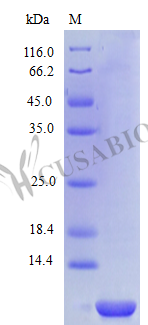Our recombinant human CCL14 protein, expressed in E. coli, encompasses the amino acid region 22-93aa of the human CCL14 protein. The protein is tag-free and supplied as a lyophilized powder, ready to be reconstituted with sterile water or buffer prior to use. The purity of this recombinant CCL14 is >96%, as confirmed by SDS-PAGE and HPLC analyses. The endotoxin level is below 1.0 EU/µg, as determined by the LAL method. The biological activity of this recombinant protein is fully preserved when compared to the standard, with an activity range of 5.0-20 ng/ml in a chemotaxis bioassay using human monocytes.
C-C motif chemokine 14 (CCL14) belongs to the CC chemokine family and plays an essential role in the immune system by modulating immune cell trafficking and function. The study of CCL14 is critical to understanding immune responses and the development of potential therapeutic interventions for various immune-related diseases.






